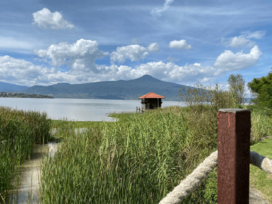Central Mexican wetlands facts for kids
Quick facts for kids Central Mexican wetlands |
|
|---|---|

|
|
| Ecology | |
| Realm | Neotropical |
| Biome | flooded grasslands and savannas |
| Geography | |
| Area | 260 km2 (100 sq mi) |
| Country | Mexico |
| States | Mexico, Michoacán, Guanajuato and Mexico City |
| Conservation | |
| Conservation status | Critical/endangered |
| Protected | 100% |
The Central Mexican wetlands are special natural areas in central Mexico. They are like huge, wet grasslands and savannas that sometimes get flooded. These areas are very important for many plants and animals.
Contents
Where are the Wetlands?
The Central Mexican wetlands are found where the southern Central Mexican Plateau meets the Trans-Mexican Volcanic Belt. This belt is a chain of mountains and volcanoes that stretches across central Mexico.
These wetlands are made up of several different wet areas:
- Lake Texcoco: This lake is in the Valley of Mexico. It's the last part of what used to be a much bigger system of lakes. The lake sits at about 2,200 meters (7,200 feet) above sea level.
- Ciénegas de Lerma: These wetlands are along the upper Lerma River in the Valley of Toluca. They cover over 3,000 hectares (7,400 acres). This is much smaller than they used to be in the late 1800s.
- Lake Pátzcuaro: This lake is in Michoacán. It's in a basin where water flows in but not out, like a big bowl. The lake is about 2,037 meters (6,683 feet) above sea level.
- Lake Cuitzeo: This lake is in Michoacán and Guanajuato. It's also in a closed basin. Its surface is about 1,830 meters (6,000 feet) above sea level.
In the past, Lake Pátzcuaro and Lake Cuitzeo were connected to the Lerma River system.
Weather in the Wetlands
The weather in these wetlands is mild, not too hot or too cold. Most of the rain falls during the summer months. The lower parts of the wetlands are a bit dry, but the higher areas in the south get more rain.
Plants of the Wetlands
The natural plants here are tall, thick reeds and cattails, which can grow over two meters (6.5 feet) high. Common wetland plants include Typha (cattails), Scirpus (bulrushes), Heleocharis (spikerushes), and Cyperus (flatsedges).
In the lakes and channels, you can find water plants like Potamogeton illinoensis, Scirpus pectinatus, and Nymphaea mexicana (a type of water lily). The ahuejote tree, also known as Salix bonplandiana (a type of willow), is a common tree found in these wet areas.
Around the wetlands, the land is often covered in dry scrub. This includes the Bajío dry forests near Lake Cuitzeo and the Central Mexican matorral in the Valley of Toluca. Near Lake Pátzcuaro, you'll find a mix of pine and oak forests with dry scrub.
Animals of the Wetlands
These wetlands are a very important home for many birds. About 200 different bird species live here, including birds that stay all year and those that migrate (travel) through.
One special bird, the black-polled yellowthroat (Geothlypis speciosa), is found only in these wetlands. This means it is endemic to this area. Sadly, two other endemic bird species are likely gone forever. The yellow rail (Coturnicops noveboracensis) hasn't been seen since 1964, and the slender-billed grackle (Quiscalus palustris) hasn't been seen since the early 1900s.
The Lake Pátzcuaro salamander (Ambystoma dumerilii) lives only in Lake Pátzcuaro. Another famous salamander, the axolotl (Ambystoma mexicanum), is found only in the wetlands of the Valley of Mexico.
The wetlands also support a lot of aquatic life, including fish. Some fish that people catch for food depend on these wetlands at different stages of their lives. Native fish species include the hooded sawfin (Skiffia lermae), Alloophorus robustus, Goodea atripinnis, Neophorus diazi, and ‘pescado blanco’ (Chirostoma estor).
Protecting the Wetlands
Sadly, the Central Mexican wetlands have shrunk a lot over time. The remaining wetlands face many dangers. Mexico City has grown and covered much of the old wetland areas in the Valley of Mexico. Water is also taken from the Lerma River to supply Mexico City and Toluca, which means less fresh water flows into the Ciénegas de Lerma.
Because more water evaporates than flows into some lakes, they are getting smaller. Water pollution and silt (dirt and sand washing into the water) also harm the marshes.
Protected Areas
Good news! Some parts of these wetlands are now protected.
- The Ciénegas del Lerma was made a special flora and fauna protection area in 2002. In 2004, it became a Ramsar site, which means it's recognized as a wetland of international importance.
- About 707 hectares (1,747 acres) of wetland at the southeastern end of Lake Pátzcuaro, called Humedales del Lago de Pátzcuaro, also became a Ramsar site in 2005.
- Some old canals and chinampas (which are like floating gardens) from the former Lake Xochimilco are saved in Xochimilco Ecological Park and Plant Market. This park is in the Xochimilco area of Mexico City. The Xochimilco wetlands are a World Heritage Site, and a large part of them (2,657 hectares or 6,566 acres) was named a Ramsar site in 2004.
See also
 In Spanish: Humedales del centro de México para niños
In Spanish: Humedales del centro de México para niños

